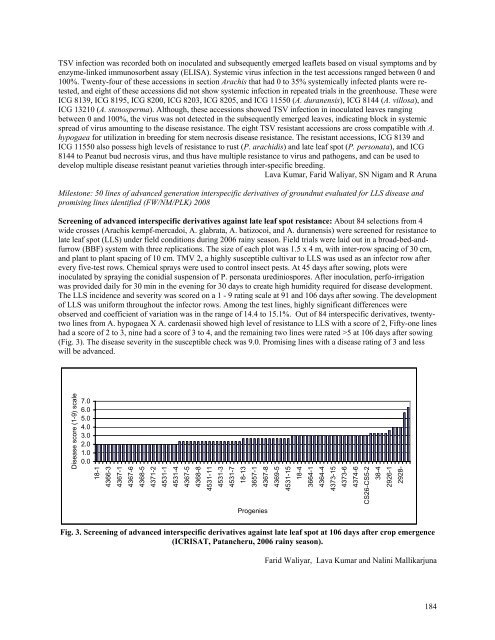ICRISAT Archival Report 2006 - The seedlings of success in the ...
ICRISAT Archival Report 2006 - The seedlings of success in the ...
ICRISAT Archival Report 2006 - The seedlings of success in the ...
You also want an ePaper? Increase the reach of your titles
YUMPU automatically turns print PDFs into web optimized ePapers that Google loves.
TSV <strong>in</strong>fection was recorded both on <strong>in</strong>oculated and subsequently emerged leaflets based on visual symptoms and by<br />
enzyme-l<strong>in</strong>ked immunosorbent assay (ELISA). Systemic virus <strong>in</strong>fection <strong>in</strong> <strong>the</strong> test accessions ranged between 0 and<br />
100%. Twenty-four <strong>of</strong> <strong>the</strong>se accessions <strong>in</strong> section Arachis that had 0 to 35% systemically <strong>in</strong>fected plants were retested,<br />
and eight <strong>of</strong> <strong>the</strong>se accessions did not show systemic <strong>in</strong>fection <strong>in</strong> repeated trials <strong>in</strong> <strong>the</strong> greenhouse. <strong>The</strong>se were<br />
ICG 8139, ICG 8195, ICG 8200, ICG 8203, ICG 8205, and ICG 11550 (A. duranensis), ICG 8144 (A. villosa), and<br />
ICG 13210 (A. stenosperma). Although, <strong>the</strong>se accessions showed TSV <strong>in</strong>fection <strong>in</strong> <strong>in</strong>oculated leaves rang<strong>in</strong>g<br />
between 0 and 100%, <strong>the</strong> virus was not detected <strong>in</strong> <strong>the</strong> subsequently emerged leaves, <strong>in</strong>dicat<strong>in</strong>g block <strong>in</strong> systemic<br />
spread <strong>of</strong> virus amount<strong>in</strong>g to <strong>the</strong> disease resistance. <strong>The</strong> eight TSV resistant accessions are cross compatible with A.<br />
hypogaea for utilization <strong>in</strong> breed<strong>in</strong>g for stem necrosis disease resistance. <strong>The</strong> resistant accessions, ICG 8139 and<br />
ICG 11550 also possess high levels <strong>of</strong> resistance to rust (P. arachidis) and late leaf spot (P. personata), and ICG<br />
8144 to Peanut bud necrosis virus, and thus have multiple resistance to virus and pathogens, and can be used to<br />
develop multiple disease resistant peanut varieties through <strong>in</strong>ter-specific breed<strong>in</strong>g.<br />
Lava Kumar, Farid Waliyar, SN Nigam and R Aruna<br />
Milestone: 50 l<strong>in</strong>es <strong>of</strong> advanced generation <strong>in</strong>terspecific derivatives <strong>of</strong> groundnut evaluated for LLS disease and<br />
promis<strong>in</strong>g l<strong>in</strong>es identified (FW/NM/PLK) 2008<br />
Screen<strong>in</strong>g <strong>of</strong> advanced <strong>in</strong>terspecific derivatives aga<strong>in</strong>st late leaf spot resistance: About 84 selections from 4<br />
wide crosses (Arachis kempf-mercadoi, A. glabrata, A. batizocoi, and A. duranensis) were screened for resistance to<br />
late leaf spot (LLS) under field conditions dur<strong>in</strong>g <strong>2006</strong> ra<strong>in</strong>y season. Field trials were laid out <strong>in</strong> a broad-bed-andfurrow<br />
(BBF) system with three replications. <strong>The</strong> size <strong>of</strong> each plot was 1.5 x 4 m, with <strong>in</strong>ter-row spac<strong>in</strong>g <strong>of</strong> 30 cm,<br />
and plant to plant spac<strong>in</strong>g <strong>of</strong> 10 cm. TMV 2, a highly susceptible cultivar to LLS was used as an <strong>in</strong>fector row after<br />
every five-test rows. Chemical sprays were used to control <strong>in</strong>sect pests. At 45 days after sow<strong>in</strong>g, plots were<br />
<strong>in</strong>oculated by spray<strong>in</strong>g <strong>the</strong> conidial suspension <strong>of</strong> P. personata ured<strong>in</strong>iospores. After <strong>in</strong>oculation, perfo-irrigation<br />
was provided daily for 30 m<strong>in</strong> <strong>in</strong> <strong>the</strong> even<strong>in</strong>g for 30 days to create high humidity required for disease development.<br />
<strong>The</strong> LLS <strong>in</strong>cidence and severity was scored on a 1 - 9 rat<strong>in</strong>g scale at 91 and 106 days after sow<strong>in</strong>g. <strong>The</strong> development<br />
<strong>of</strong> LLS was uniform throughout <strong>the</strong> <strong>in</strong>fector rows. Among <strong>the</strong> test l<strong>in</strong>es, highly significant differences were<br />
observed and coefficient <strong>of</strong> variation was <strong>in</strong> <strong>the</strong> range <strong>of</strong> 14.4 to 15.1%. Out <strong>of</strong> 84 <strong>in</strong>terspecific derivatives, twentytwo<br />
l<strong>in</strong>es from A. hypogaea X A. cardenasii showed high level <strong>of</strong> resistance to LLS with a score <strong>of</strong> 2, Fifty-one l<strong>in</strong>es<br />
had a score <strong>of</strong> 2 to 3, n<strong>in</strong>e had a score <strong>of</strong> 3 to 4, and <strong>the</strong> rema<strong>in</strong><strong>in</strong>g two l<strong>in</strong>es were rated >5 at 106 days after sow<strong>in</strong>g<br />
(Fig. 3). <strong>The</strong> disease severity <strong>in</strong> <strong>the</strong> susceptible check was 9.0. Promis<strong>in</strong>g l<strong>in</strong>es with a disease rat<strong>in</strong>g <strong>of</strong> 3 and less<br />
will be advanced.<br />
Disease score (1-9) scale<br />
7.0<br />
6.0<br />
5.0<br />
4.0<br />
3.0<br />
2.0<br />
1.0<br />
0.0<br />
18-1<br />
4366-3<br />
4367-1<br />
4367-6<br />
4368-5<br />
4371-2<br />
4531-1<br />
4531-4<br />
4367-5<br />
4368-8<br />
4531-11<br />
4531-3<br />
4531-7<br />
18-13<br />
3657-1<br />
4367-8<br />
4369-5<br />
4531-15<br />
18-4<br />
3664-1<br />
4364-4<br />
4373-15<br />
4373-6<br />
4374-6<br />
CS26-CS5-2<br />
38-4<br />
2926-1<br />
2928-<br />
Progenies<br />
Fig. 3. Screen<strong>in</strong>g <strong>of</strong> advanced <strong>in</strong>terspecific derivatives aga<strong>in</strong>st late leaf spot at 106 days after crop emergence<br />
(<strong>ICRISAT</strong>, Patancheru, <strong>2006</strong> ra<strong>in</strong>y season).<br />
Farid Waliyar, Lava Kumar and Nal<strong>in</strong>i Mallikarjuna<br />
184

















